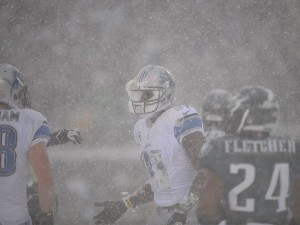Being both a sports fan and a weather weenie, I was especially excited about watching my favorite Detroit Lions take on the Philadelphia Eagles in what can only be described as a “Snow Bowl” on Sunday! (Let’s not talk about the Lions’ outcome for now…) Apparently, I’m not the only person out there who is a fan of watching football take place in heavy snow! On Twitter, #DETvsPHI was trending at #2 for most of the afternoon, and #SnowBowl made an appearance on the trending list. Three other games took place in the snow, as well (Kansas City Chiefs at Washington Redskins, Miami Dolphins at Pittsburgh Steelers, and Minnesota Vikings at Baltimore Ravens), but the Lions-Eagles game took the prize for snow accumulation during the game!

#81 Calvin Johnson with a helmet full of snow during the Detroit Lions @ Philadelphia Eagles game on December 8, 2013. Photo courtesy of G.Smith/Detroit Lions.
Much to my chagrin, though, the hashtag #BlizzardBowl also trended upward during the game. To a meteorologist, using the wrong word to define a snowstorm is egregious as, say, yelling “fire” in a theater when someone lights a match outside its doors. To us, it’s crying wolf, creating hype, exaggerating the situation. We want the scientific facts to match the scientific terms being used. Then again, even my favorite historical weather observer might have been using the word a little outside its meteorological definition. But we’ll get there in a moment.
To a meteorologist, a snowstorm must meet a very specific set of criteria to qualify as a blizzard:
- Snow falling and/or blowing that causes visibility to drop to a quarter mile or less;
- Winds of 35 mph or greater (either steady or frequently gusting above that speed); and
- These conditions lasting for at least three consecutive hours.
Meteorologists reserve the strongest wording for the most dangerous events, and we do it for a reason. When we forecast a blizzard, we want people to know that conditions are beyond the usual snowstorm, that they are even more dangerous than a heavy snow by itself. We as meteorologists hope that our citizens will prepare accordingly – the higher the threat, the greater the urgency in preparation. If we seem a bit defensive about reserving the word “blizzard” for a storm that truly is a blizzard, it is because we want our citizens to not become complacent about what the worst can be. That event in early October in western South Dakota was a true blizzard, and it has had lasting and widespread impacts to ranchers and farmers, at the very least, not to mention the folks who were stranded in their homes for days.
The snow falling in Philadelphia on Sunday was heavy, for sure, but it was not accompanied by very strong winds, and the low visibility did not last for three consecutive hours. (For the weather-curious, the winds peaked at a mere 10 mph during the snowfall, the low visibility lasted for 2 hours and 37 minutes, and the lowest visibility and highest winds did not coincide. The 8.6” of snow on December 8 was impressive, though. You can look up the weather history at Philadelphia here.) An 8-inch snowfall in a major city certainly has impacts, far beyond making a football game a little more entertaining, but it isn’t as dangerous as a true blizzard.
Coming back to my favorite weather historian… Laura used the word “blizzard” quite a bit in her books, especially during The Long Winter. Were all of those true blizzards?
Likely, the answer is “no” – Laura probably did not account for wind speed, visibility, and duration criteria when she called those nasty snowstorms “blizzards” throughout her books. She, like many of those who were on Twitter on Sunday, probably saw pretty bad conditions and used the word “blizzard” in a descriptive sense, rather than as a scientific definition. Then again, Laura did live in a part of the country where true blizzards are much more common. Her criteria for a blizzard was truly “impact-based”, to use a buzzword that we use in the meteorology community. Laura’s blizzard definition might look more like this:
- Cannot go to town, school, or anywhere (even travel across the street is not recommended);
- Must use rope to move between house and barn;
- Cannot see hand in front of face;
- Cattle noses freeze to the ground; and
- Lasts 2 to 4 days (usually 3 days).
Come to think of it, maybe she had the definition of a blizzard pretty well nailed, after all.

I too love those football games when the millionare players have to earn their money playing out in the elements. Nothing like snow, rain, sleet, or wind to change the outcome of a game, while you are sitting comfortably at home watching from the couch! Take the “Ice Bowl” game of December 31, 1967 at Lambeau Field when the Packers played the Cowboys. The temperature was -15F with a wind chill nearly 50 below! Now thats what I call braving the elements. To those teams that have domed stadiums – bah humbug!